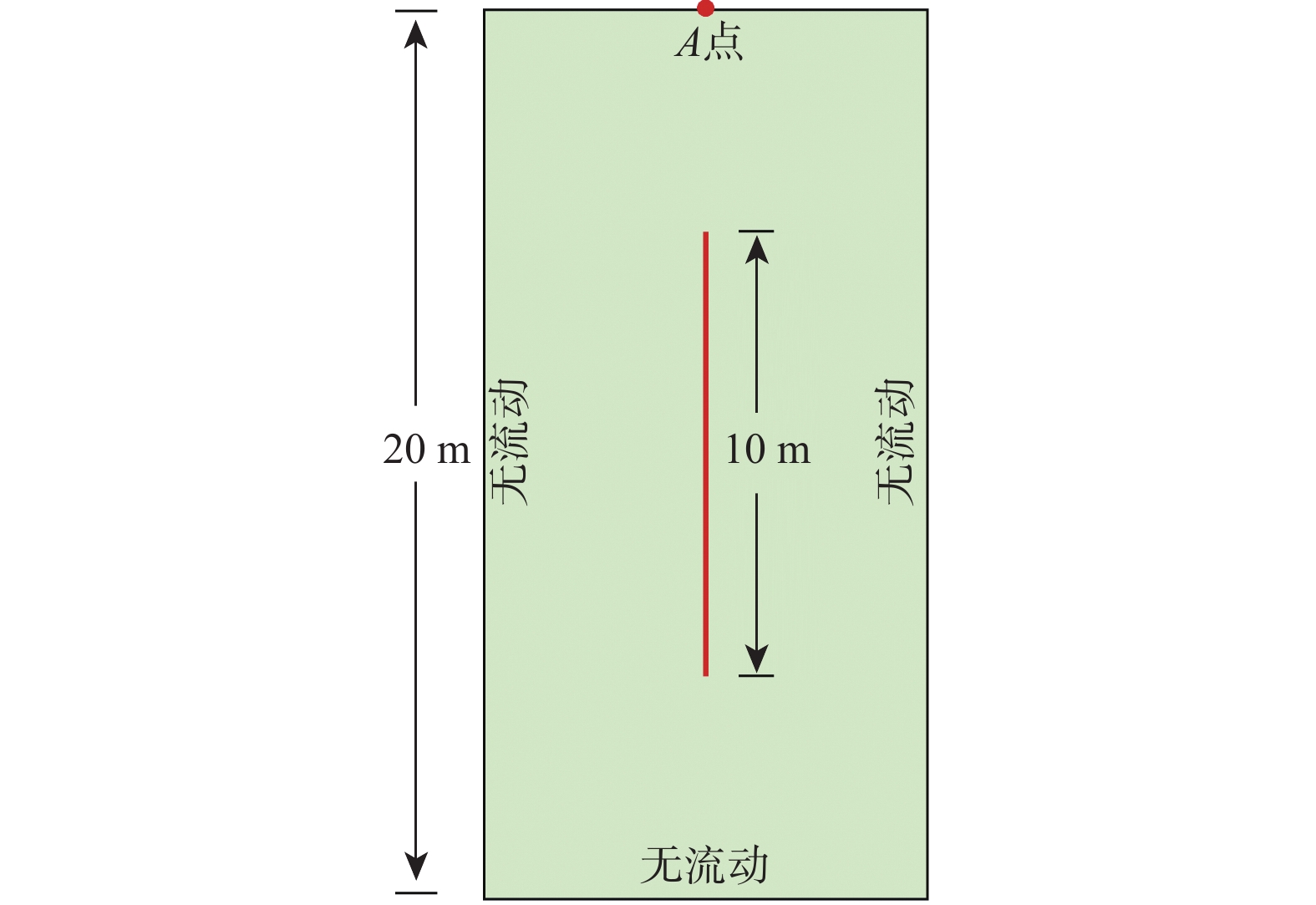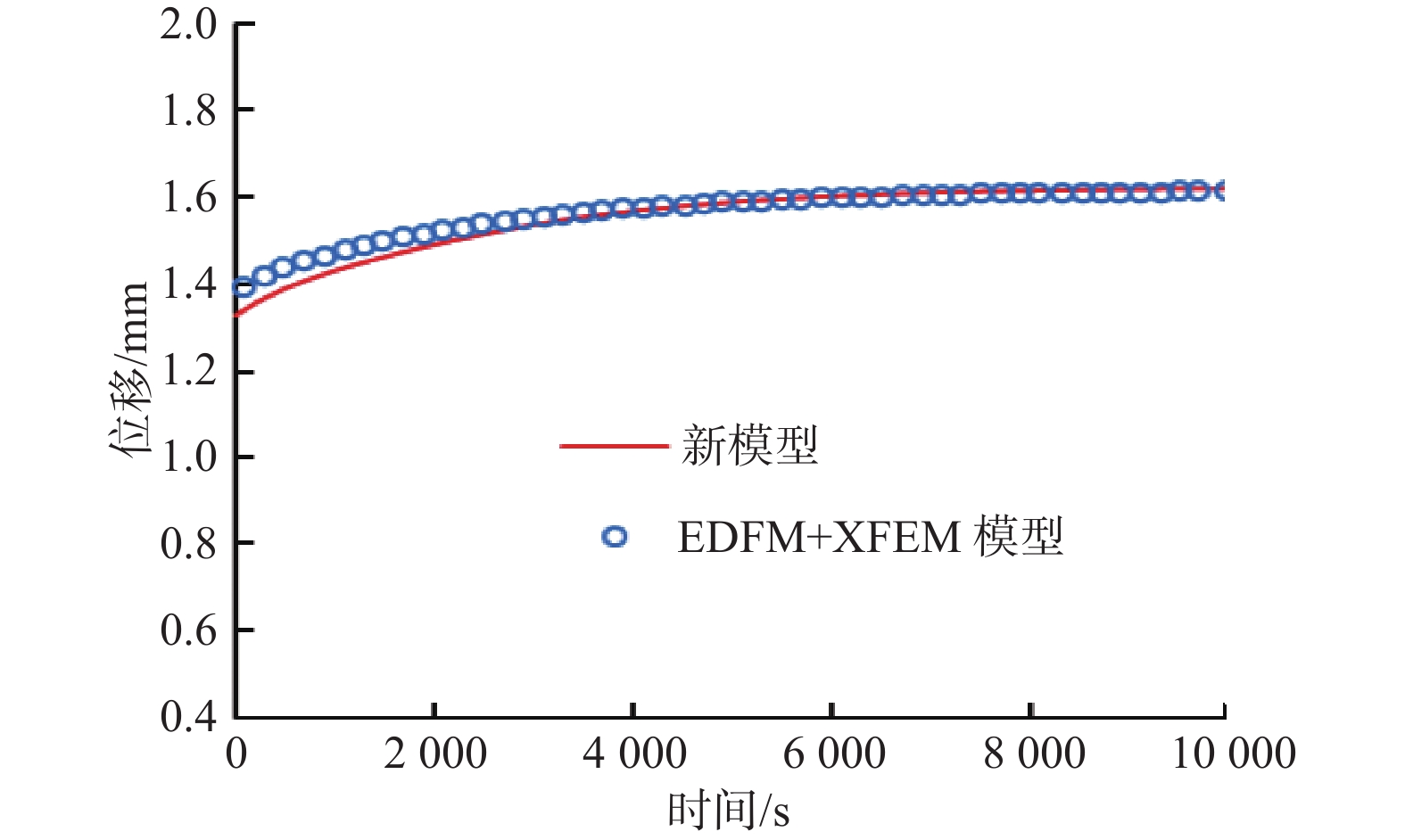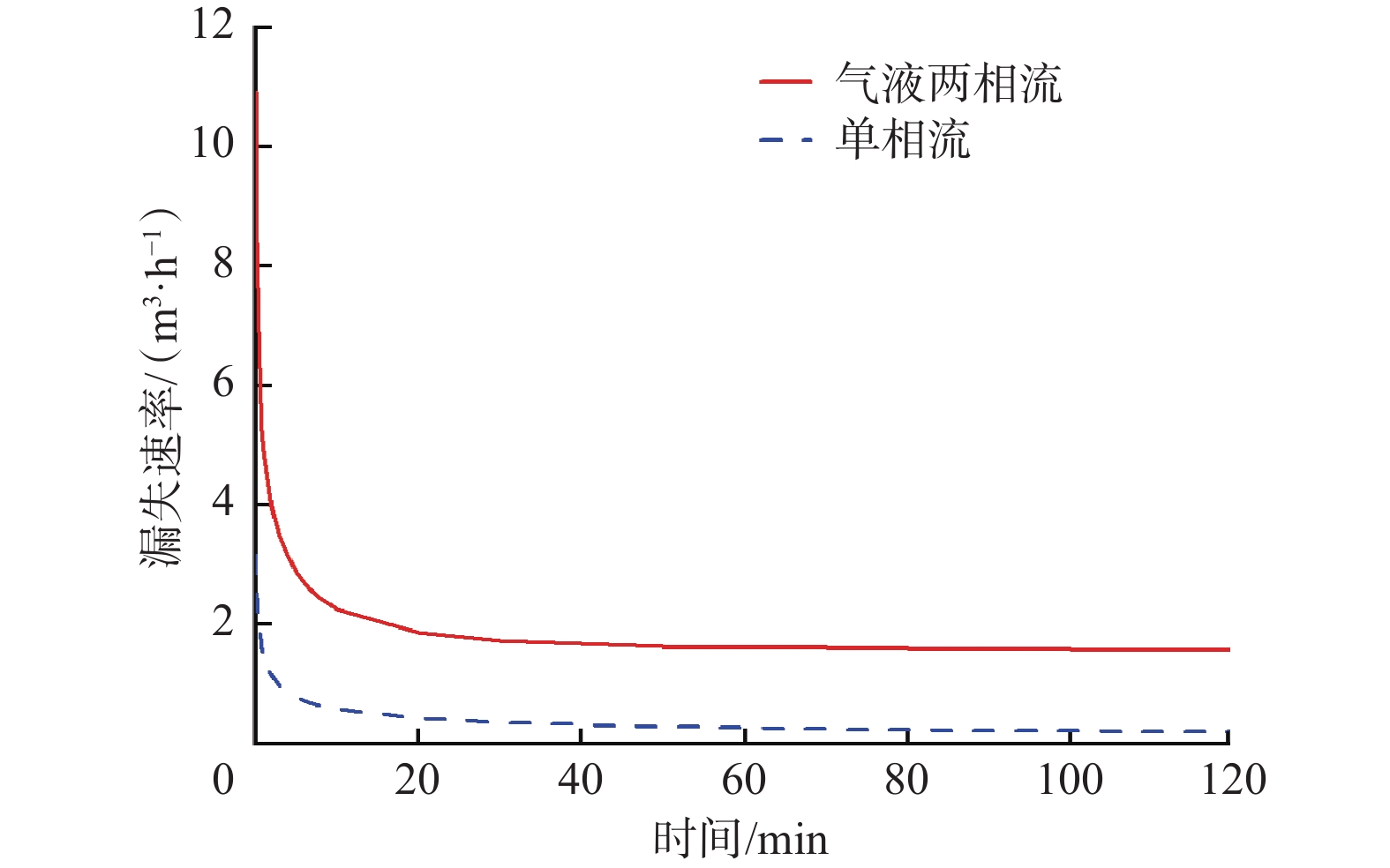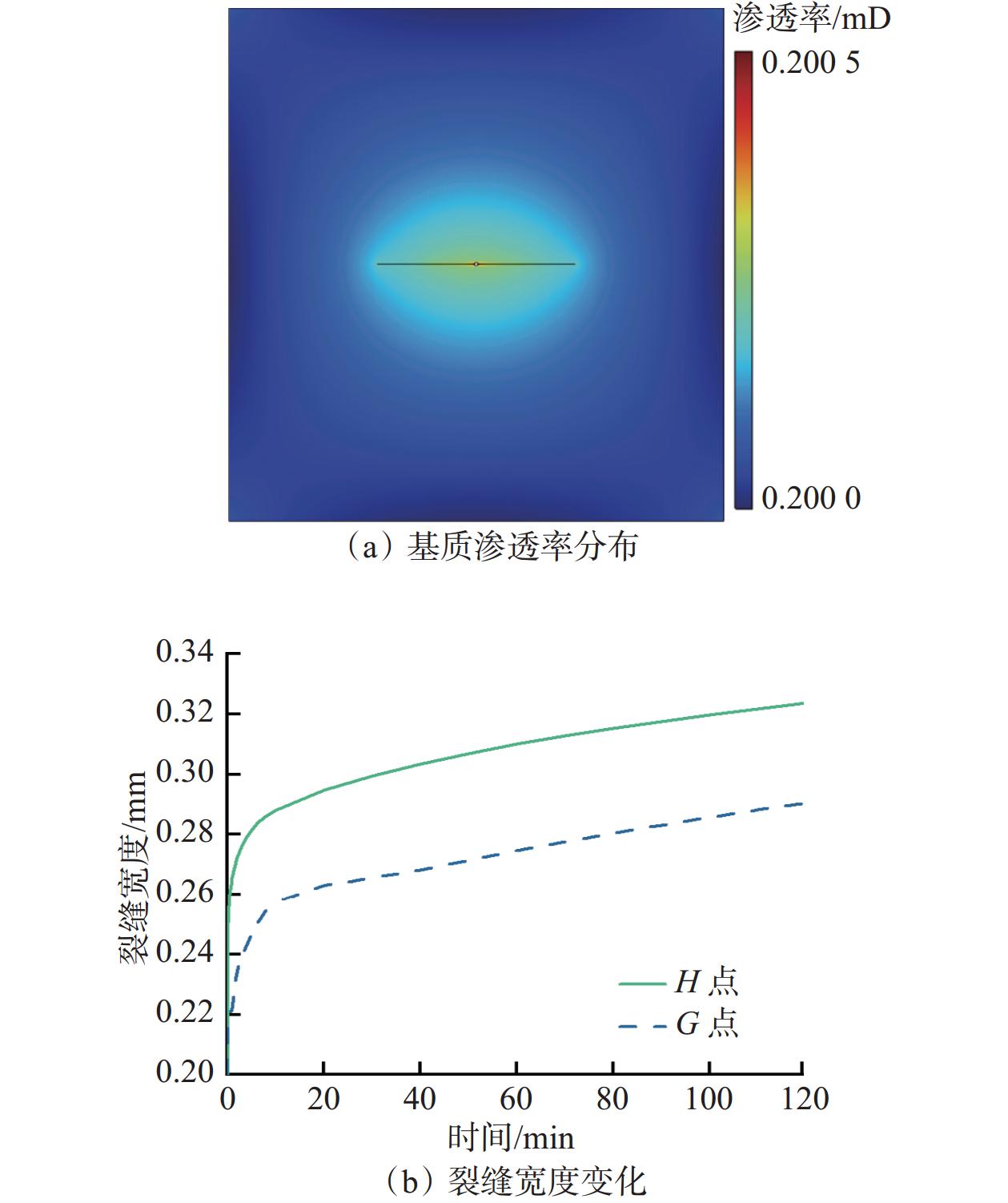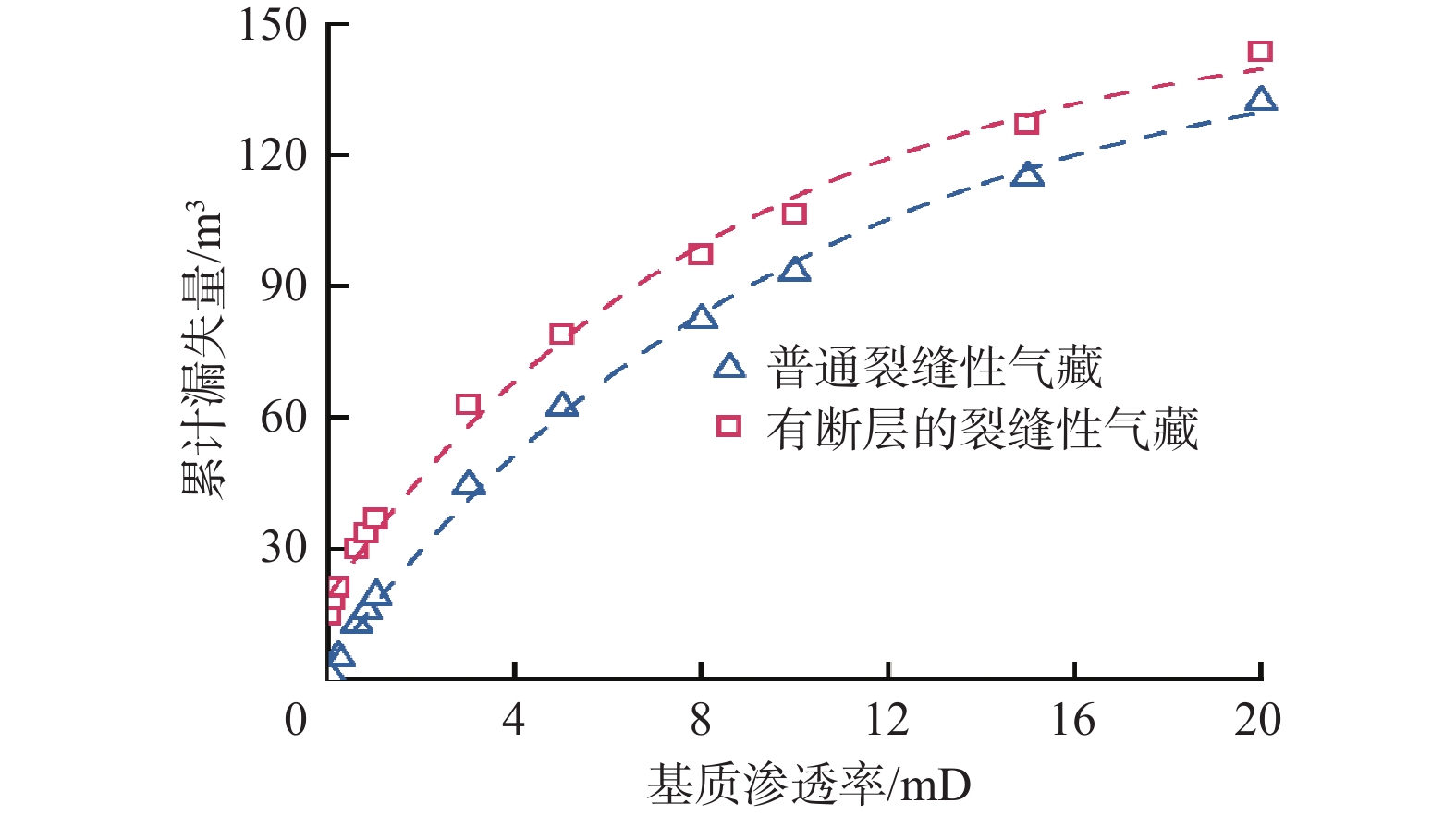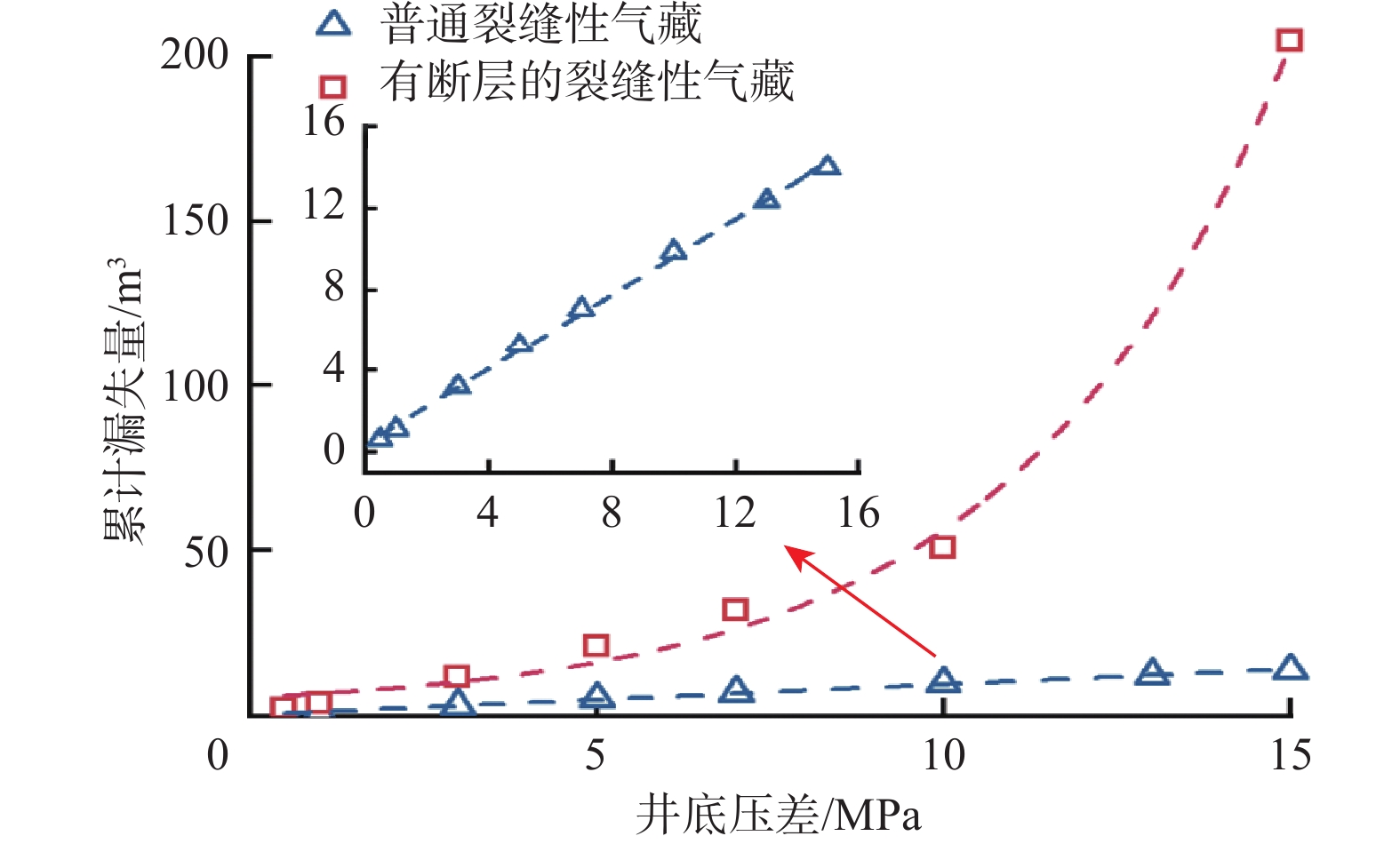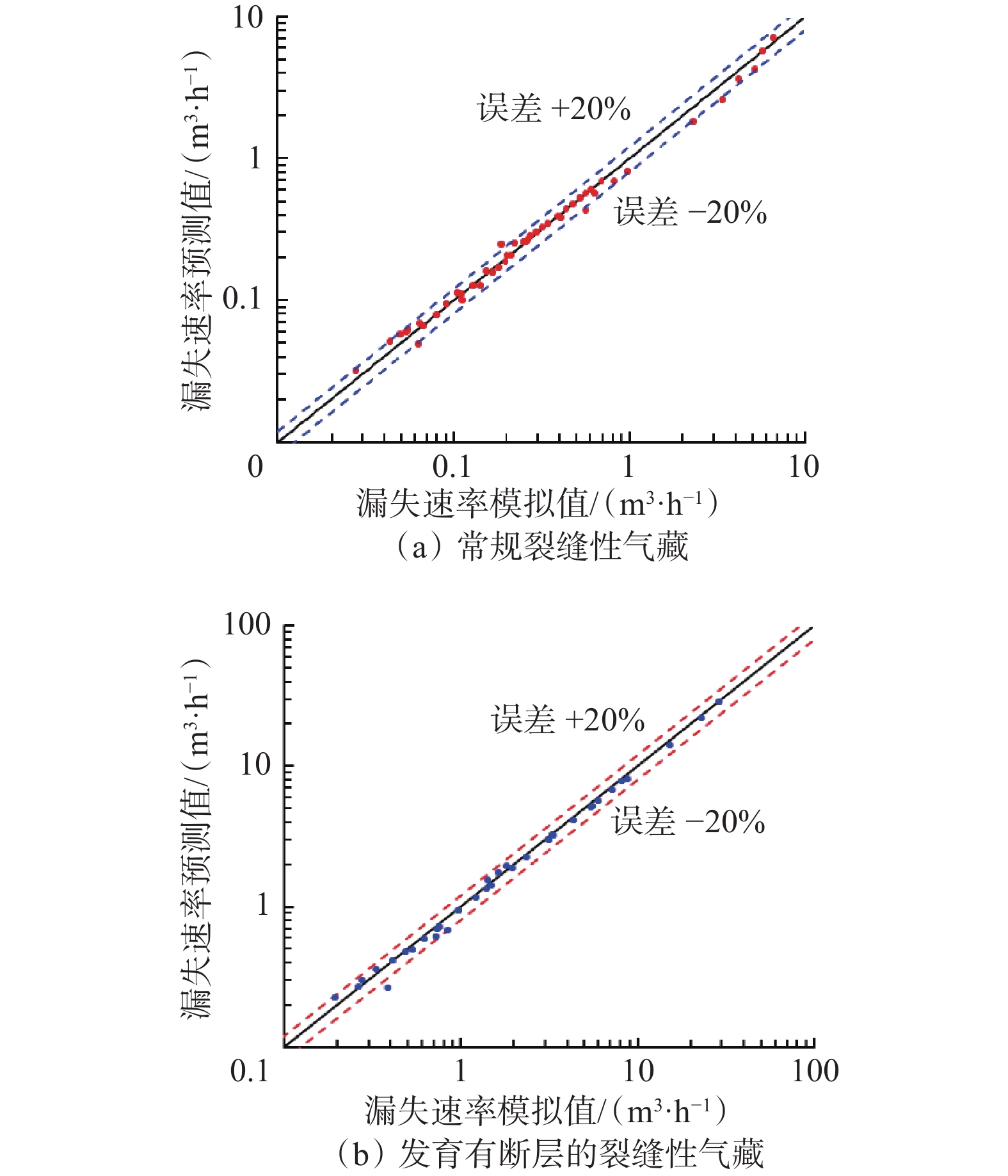Numerical Study on Drilling Fluid Leakage under Fluid-Solid Coupling in Deep Fractured Gas Reservoir
-
摘要:
裂缝性地层钻井过程中井漏问题严峻,易导致产能降低和钻井安全事故。为此,综合考虑钻井液与天然气的物性差异、基质与裂缝间的耦合流动及裂缝开度的动态演化规律,建立了基于气液两相流动的裂缝性气藏漏失预测模型,并与实验数据进行对比,验证了模型的准确性;基于该模型,系统分析了气藏地质构造、基质参数、裂缝参数和井底压差等因素对漏失的影响规律,修正了传统统计学漏失模型,提出了适用于裂缝性气藏的漏失速率表征方法。研究结果表明,裂缝性气藏的漏失速率随着裂缝宽度增大呈对数函数增长,增长趋势先急后缓,随着井底压差和裂缝长度增大呈线性增长;发育有断层的裂缝性气藏的漏失速率随着裂缝宽度和井底压差增大呈指数增长,随着井眼与断层的距离增大呈对数式下降。研究结果为完善裂缝性气藏井漏规律和优选防漏堵漏技术提供了理论依据。
Abstract:During the drilling process in fractured formations, the issue of well leakage is severe, which can easily lead to reduced productivity and drilling safety accidents. To address this problem, this study comprehensively the differences of physical properties between mud and gas, coupled flow between matrix and fractures and the hydro-mechanical coupling. A mud loss model for fractured gas reservoirs with a gas–liquid two-phase flow was established, and its accuracy was verified by comparing it with physical experiments. Based on this model, the influence of geological structure, matrix parameters, fracture parameters, and bottom-hole pressure difference on lost circulation was analyzed. Furthermore, the traditional statistical mud-loss model was refined, and a method of leakage rate characterization suitable for fractured gas reservoirs was established. The results indicate that the loss rate increases linearly with the increase in bottom-hole pressure difference and fracture length in conventional fractured gas reservoirs, and increases in a logarithmic function with an increase in fracture width, the growth trend is first rapid and then slow. But for fractured gas reservoirs with developed faults, the loss rate increases exponentially with the increase in fracture width and bottom-hole pressure difference, and decreases logarithmically with an increase in the distance between the wellbore and fault. The conclusions drawn can provide theoretical references for further understanding the lost circulation and plugging technologies in deep fractured gas reservoirs.
-
-
-
[1] 刘岩生,张佳伟,黄洪春. 中国深层—超深层钻完井关键技术及发展方向[J]. 石油学报,2024,45(1):312–324. doi: 10.7623/syxb202401018 LIU Yansheng, ZHANG Jiawei, HUANG Hongchun. Key technologies and development direction for deep and ultra-deep drilling and completion in China[J]. Acta Petrolei Sinica, 2024, 45(1): 312–324. doi: 10.7623/syxb202401018
[2] 杨鹏程,薛浩楠,李升,等. 超深层高压油气藏天然气偏差系数计算新模型[J]. 石油钻探技术,2023,51(6):106–114. doi: 10.11911/syztjs.2023112 YANG Pengcheng, XUE Haonan, LI Sheng, et al. A new model for calculating deviation factor of natural gas in ultra-deep oil and gas reservoirs under high pressure[J]. Petroleum Drilling Techniques, 2023, 51(6): 106–114. doi: 10.11911/syztjs.2023112
[3] 房超,张辉,陈朝伟,等. 地质工程一体化漏失机理与预防措施:以塔里木库车山前古近系复合盐层为例[J]. 石油钻采工艺,2022,44(6):684–692. FANG Chao, ZHANG Hui, CHEN Zhaowei, et al. Geology-engineering integrated investigation of leakoff mechanisms and prevention measures: a case study of the Palaeogene composite salt layer in the Kuqa piedmont zone, Tarim Basin[J]. Oil Drilling & Production Technology, 2022, 44(6): 684–692.
[4] 曲鸿雁,胡佳伟,周福建,等. 深层裂缝性致密砂岩气藏基质–裂缝气体流动机理[J]. 石油钻探技术,2024,52(2):153–164. doi: 10.11911/syztjs.2024045 QU Hongyan, HU Jiawei, ZHOU Fujian, et al. Mechanism of gas flow in matrix-fracture in deep fractured tight sandstone gas reservoirs[J]. Petroleum Drilling Techniques, 2024, 52(2): 153–164. doi: 10.11911/syztjs.2024045
[5] XIA Yang, JIN Yan, CHEN Mian, et al. Hydrodynamic modeling of mud loss controlled by the coupling of discrete fracture and matrix[J]. Journal of Petroleum Science and Engineering, 2015, 129: 254–267. doi: 10.1016/j.petrol.2014.07.026
[6] LI Lei, YANG Jin, SONG Yu, et al. Numerical study of the mud loss in naturally fractured oil layers with two-phase flow model[J]. Journal of Petroleum Science and Engineering, 2022, 210: 110040. doi: 10.1016/j.petrol.2021.110040
[7] 张矿生,宫臣兴,陆红军,等. 基于集成学习的井漏智能预警模型及智能推理方法[J]. 石油钻采工艺,2023,45(1):47–54. ZHANG Kuangsheng, GONG Chenxing, LU Hongjun, et al. Intelligent early warning model and intelligent reasoning method based on integrated learning for loss circulation[J]. Oil Drilling & Production Technology, 2023, 45(1): 47–54.
[8] 朱明明,孙欢,孙艳,等. 陇东致密油区域恶性出水漏层堵漏技术[J]. 石油钻探技术,2023,51(6):50–56. doi: 10.11911/syztjs.2023003 ZHU Mingming, SUN Huan, SUN Yan, et al. Loss circulation control technology for malignant water leakage layer in Longdong tight oil region[J]. Petroleum Drilling Techniques, 2023, 51(6): 50–56. doi: 10.11911/syztjs.2023003
[9] 康毅力,田国丰,游利军,等. 缝面摩滑:深部裂缝性地层钻井液漏失加剧的新机制[J]. 石油钻探技术,2022,50(1):45–53. doi: 10.11911/syztjs.2021033 KANG Yili, TIAN Guofeng, YOU Lijun, et al. Friction & sliding on fracture surfaces: a new mechanism for increasing drilling fluid leakage in deep fractured reservoirs[J]. Petroleum Drilling Techniques, 2022, 50(1): 45–53. doi: 10.11911/syztjs.2021033
[10] LIETARD O, UNWIN T, GUILLOT D, et al. Fracture width LWD and drilling Mud/LCM selection guidelines in naturally fractured reservoirs[R]. SPE 36832, 1996.
[11] SANFILLIPPO F, BRIGNOLI M, SANTARELLI F J, et al. Characterization of conductive fractures while drilling[R]. SPE 38177, 1997.
[12] LAVROV A, TRONVOLL J. Mechanics of borehole ballooning in naturally-fractured formations[R]. SPE 93747, 2005.
[13] 李大奇,曾义金,刘四海,等. 基于分形理论的粗糙裂缝钻井液漏失模型研究[J]. 石油钻探技术,2017,45(4):46–52. LI Daqi, ZENG Yijin, LIU Sihai, et al. Drilling fluid loss model in rough fractures based on fractal theory[J]. Petroleum Drilling Techniques, 2017, 45(4): 46–52.
[14] MAJIDI R, MISKA S Z, AHMED R, et al. Radial flow of yield-power-law fluids: Numerical analysis, experimental study and the application for drilling fluid losses in fractured formations[J]. Journal of Petroleum Science and Engineering, 2010, 70(3/4): 334–343.
[15] 李大奇,刘四海,康毅力,等. 天然裂缝性地层钻井液漏失规律研究[J]. 西南石油大学学报(自然科学版),2016,38(3):101–106. LI Daqi, LIU Sihai, KANG Yili, et al. Dynamic behavior of drilling fluid leakage in naturally fractured formations[J]. Journal of Southwest Petroleum University(Science & Technology Edition), 2016, 38(3): 101–106.
[16] 贾利春,陈勉,侯冰,等. 裂缝性地层钻井液漏失模型及漏失规律[J]. 石油勘探与开发,2014,41(1):95–101. doi: 10.11698/PED.2014.01.12 JIA Lichun, CHEN Mian, HOU Bing, et al. Drilling fluid loss model and loss dynamic behavior in fractured formations[J]. Petroleum Exploration and Development, 2014, 41(1): 95–101. doi: 10.11698/PED.2014.01.12
[17] OZDEMIRTAS M, KURU E, BABADAGLI T. Experimental investigation of borehole ballooning due to flow of non-Newtonian fluids into fractured rocks[J]. International Journal of Rock Mechanics and Mining Sciences, 2010, 47(7): 1200–1206. doi: 10.1016/j.ijrmms.2010.07.002
[18] 王明波,郭亚亮,方明君,等. 裂缝性地层钻井液漏失动力学模拟及规律[J]. 石油学报,2017,38(5):597–606. doi: 10.7623/syxb201705013 WANG Mingbo, GUO Yaliang, FANG Mingjun, et al. Dynamics simulation and laws of drilling fluid loss in fractured formations[J]. Acta Petrolei Sinica, 2017, 38(5): 597–606. doi: 10.7623/syxb201705013
[19] 李大奇. 裂缝性地层钻井液漏失动力学研究[D]. 成都:西南石油大学,2012. LI Daqi. Numerical and experimental investigations of drilling fluid losses in fractured formations[D]. Chengdu: Southwest Petroleum University, 2012.
[20] 牛骏,苏建政,严侠,等. 基于嵌入式离散裂缝和扩展有限元的裂缝性页岩油藏流固耦合高效数值模拟方法[J]. 科学技术与工程,2020,20(7):2643–2651. doi: 10.3969/j.issn.1671-1815.2020.07.017 NIU Jun, SU Jianzheng, YAN Xia, et al. An efficient numerical simulation method with hydro-mechanical coupling model of fractured shale oil reservoir based on embedded discrete fracture model and extended finite element method[J]. Science Technology and Engineering, 2020, 20(7): 2643–2651. doi: 10.3969/j.issn.1671-1815.2020.07.017
[21] 陈志明,张绍琦,周彪,等. 考虑离散裂缝的非均质裂缝性气藏数值试井新模型[J]. 天然气工业,2023,43(2):77–86. doi: 10.3787/j.issn.1000-0976.2023.02.008 CHEN Zhiming, ZHANG Shaoqi, ZHOU Biao, et al. A new numerical well testing model considering discrete fractures for heterogeneous fractured gas reservoirs[J]. Natural Gas Industry, 2023, 43(2): 77–86. doi: 10.3787/j.issn.1000-0976.2023.02.008
[22] 金泰宇. 三维粗糙裂缝网络钻井液漏失流固耦合模型研究[J]. 石油钻探技术,2024,52(1):69–77. doi: 10.11911/syztjs.2023100 JIN Taiyu. Study on three-dimensional fluid-solid coupling model of drilling fluid leakage in rough fracture network[J]. Petroleum Drilling Techniques, 2024, 52(1): 69–77. doi: 10.11911/syztjs.2023100
[23] 房娜,刘宗宾,岳宝林,等. 裂缝性油藏渗流特征及注水策略[J]. 特种油气藏,2024,31(3):91–97. doi: 10.3969/j.issn.1006-6535.2024.03.012 FANG Na, LIU Zongbin, YUE Baolin, et al. Seepage characteristics and water injection strategy of fractured reservoir[J]. Special Oil & Gas Reservoirs, 2024, 31(3): 91–97. doi: 10.3969/j.issn.1006-6535.2024.03.012
[24] PENG Yan, LIU Jishan, PAN Zhejun, et al. A sequential model of shale gas transport under the influence of fully coupled multiple processes[J]. Journal of Natural Gas Science and Engineering, 2015, 27(Part 2): 808-821.
[25] 高永海. 深水油气钻探井筒多相流动与井控的研究[D]. 青岛:中国石油大学(华东),2007. GAO Yonghai. Study on multi-phase flow in wellbore and well control in deep water drilling[D]. Qingdao: China University of Petroleum(East China), 2007.
[26] 李宁,刘洪涛,张权,等. 大温压域钻井液流变参数预测模型[J]. 钻井液与完井液,2023,40(2):143–155. doi: 10.12358/j.issn.1001-5620.2023.02.001 LI Ning, LIU Hongtao, ZHANG Quan, et al. Model for predicting drilling fluid rheological parameters in wide temperature and pressure range[J]. Drilling Fluid & Completion Fluid, 2023, 40(2): 143–155. doi: 10.12358/j.issn.1001-5620.2023.02.001
[27] WEI Shiming, JIN Yan, XIA Yang. Predict the mud loss in natural fractured vuggy reservoir using discrete fracture and discrete vug network model[J]. Journal of Petroleum Science and Engineering, 2020, 195: 107626. doi: 10.1016/j.petrol.2020.107626
[28] LIAO Youqiang, WANG Zhiyuan, CHAO Mingzhe, et al. Coupled wellbore–reservoir heat and mass transfer model for horizontal drilling through hydrate reservoir and application in wellbore stability analysis[J]. Journal of Natural Gas Science and Engineering, 2021, 95: 104216. doi: 10.1016/j.jngse.2021.104216
[29] 黄朝琴,高博,王月英,等. 基于模拟有限差分法的离散裂缝模型两相流动模拟[J]. 中国石油大学学报(自然科学版),2014,38(6):97–105. doi: 10.3969/j.issn.1673-5005.2014.06.015 HUANG Zhaoqin, GAO Bo, WANG Yueying, et al. Two-phase flow simulation of discrete fracture model using a novel mimetic finite difference method[J]. Journal of China University of Petroleum (Edition of Natural Science), 2014, 38(6): 97–105. doi: 10.3969/j.issn.1673-5005.2014.06.015
[30] YAN Xia, HUANG Zhaoqin, YAO Jun, et al. An efficient numerical hybrid model for multiphase flow in deformable fractured-shale reservoirs[J]. SPE Journal, 2018, 23(4): 1412–1437. doi: 10.2118/191122-PA
[31] LIU Jia, XUE Yi, ZHANG Qi, et al. Coupled thermo-hydro-mechanical modelling for geothermal doublet system with 3D fractal fracture[J]. Applied Thermal Engineering, 2022, 200: 117716. doi: 10.1016/j.applthermaleng.2021.117716
[32] 滕学清,孙宝江,张耀明,等. 无安全压力窗口裂缝性地层五步压回法压井方法[J]. 石油钻探技术,2018,46(6):20–25. TENG Xueqing, SUN Baojiang, ZHANG Yaoming, et al. A five-step bullheading killing well control method for fractured formations without a safety pressure window[J]. Petroleum Drilling Techniques, 2018, 46(6): 20–25.
[33] 张磊,许杰,谢涛,等. 几种裂缝性漏失压力计算模型的比较分析[J]. 石油机械,2018,46(9):13–17. ZHANG Lei, XU Jie, XIE Tao, et al. Comparison of several calculation models for loss pressure of fractured formation[J]. China Petroleum Machinery, 2018, 46(9): 13–17.
[34] 金衍,陈勉,刘晓明,等. 塔中奥陶系碳酸盐岩地层漏失压力统计分析[J]. 石油钻采工艺,2007,29(5):82–84. doi: 10.3969/j.issn.1000-7393.2007.05.023 JIN Yan, CHEN Mian, LIU Xiaoming, et al. Statistic analysis of leakage pressure of Ordovician carbonate formation in middle Tarim Basin[J]. Oil Drilling & Production Technology, 2007, 29(5): 82–84. doi: 10.3969/j.issn.1000-7393.2007.05.023



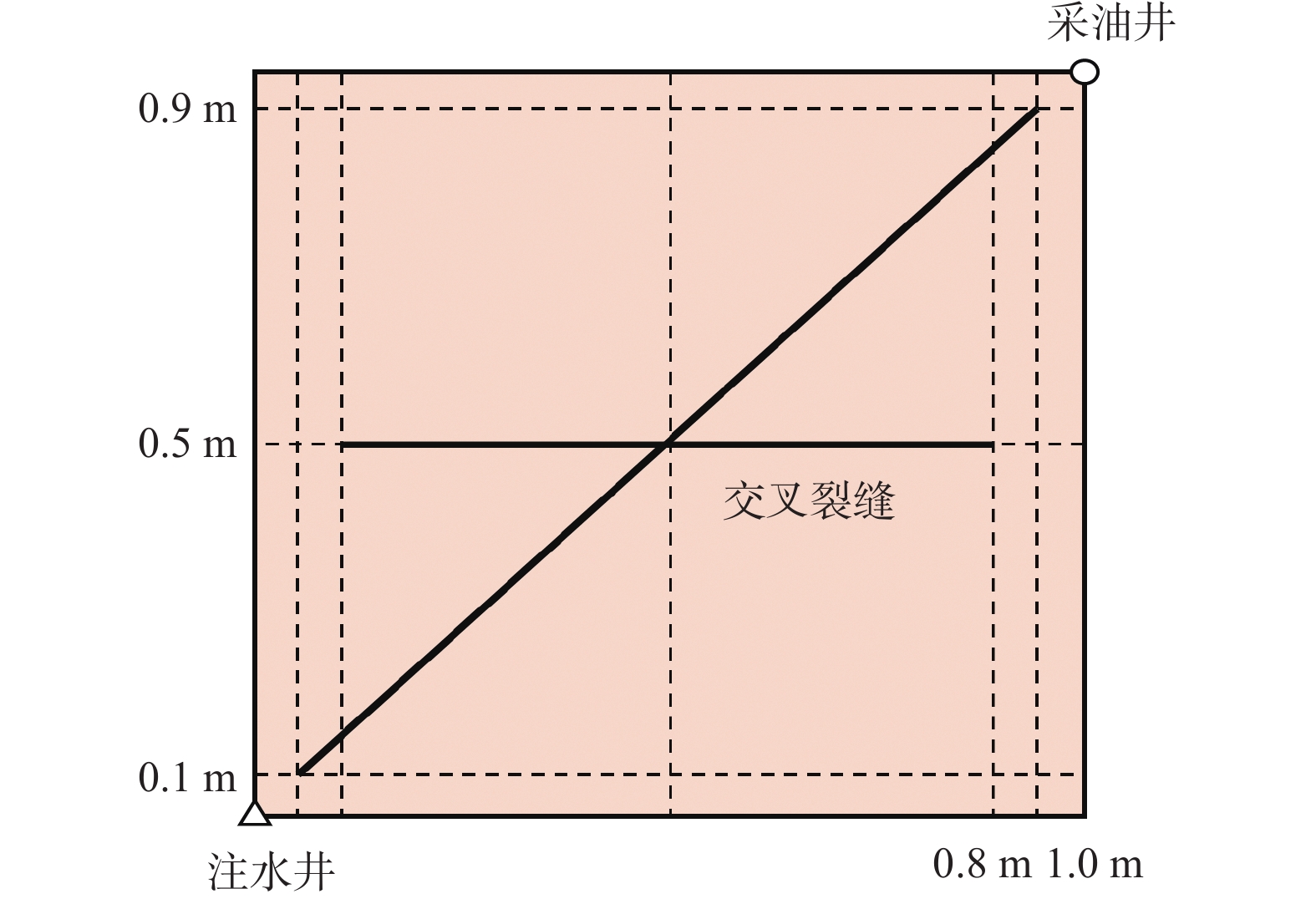
 下载:
下载:

